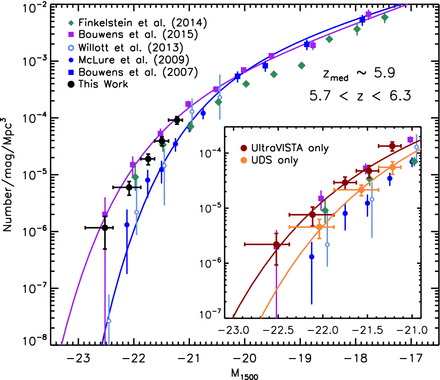We present the results of a search for bright (−22.7 ≤ MUV ≤ −20.5) Lyman-break galaxies at z ≃ 6 within a total of 1.65 deg2 of imaging in the UltraVISTA/Cosmological Evolution Survey (COSMOS) and United Kingdom Infrared Telescope Deep Sky Survey (UKIDSS) Ultra Deep Survey (UDS) fields. The deep near-infrared imaging available in the two independent fields, in addition to deep optical (including z′-band) data, enables the sample of z ≃ 6 star-forming galaxies to be securely detected longward of the break (in contrast to several previous studies). We show that the expected contamination rate of our initial sample by cool Galactic brown dwarfs is ≲3 per cent and demonstrate that they can be effectively removed by fitting brown dwarf spectral templates to the photometry. At z≃ 6, the galaxy surface density in the UltraVISTA field exceeds that in the UDS by a factor of ≃ 1.8, indicating strong cosmic variance even between degree-scale fields at z > 5. We calculate the bright end of the rest-frame Ultraviolet (UV) luminosity function (LF) at z ≃ 6.

The rest-frame UV LF at z ≃ 6, showing our results from the combined UltraVISTA/COSMOS and UDS/SXDS data sets as the black circles. The redshift range is restricted to 5.7 < z < 6.3 as in McLure et al. (2009), which results in a median redshift of zmed ∼ 5.9. The inset plot shows our results from the UltraVISTA/COSMOS and UDS/SXDS fields separately as the red and orange points, respectively, with the best-fitting Schechter functions overplotted in identical colours. Here, we have not corrected the absolute magnitudes for dust extinction. We have shifted the Willott et al. (2013) points by 0.05 mag faintward for clarity.
The galaxy number counts are a factor of ∼1.7 lower than predicted by the recent LF determination by Bouwens et al. In comparison to other smaller area studies, we find an evolution in the characteristic magnitude between z ≃ 5 and z ≃ 7 of ΔM* ∼ 0.4, and show that a double power law or a Schechter function can equally well describe the LF at z = 6. Furthermore, the bright end of the LF appears to steepen from z ≃ 7 to z ≃ 5, which could indicate the onset of mass quenching or the rise of dust obscuration, a conclusion supported by comparing the observed LFs to a range of theoretical model predictions.
Further details can be found in Bowler, R.A et al. 2015, MNRAS, 452, 1817
